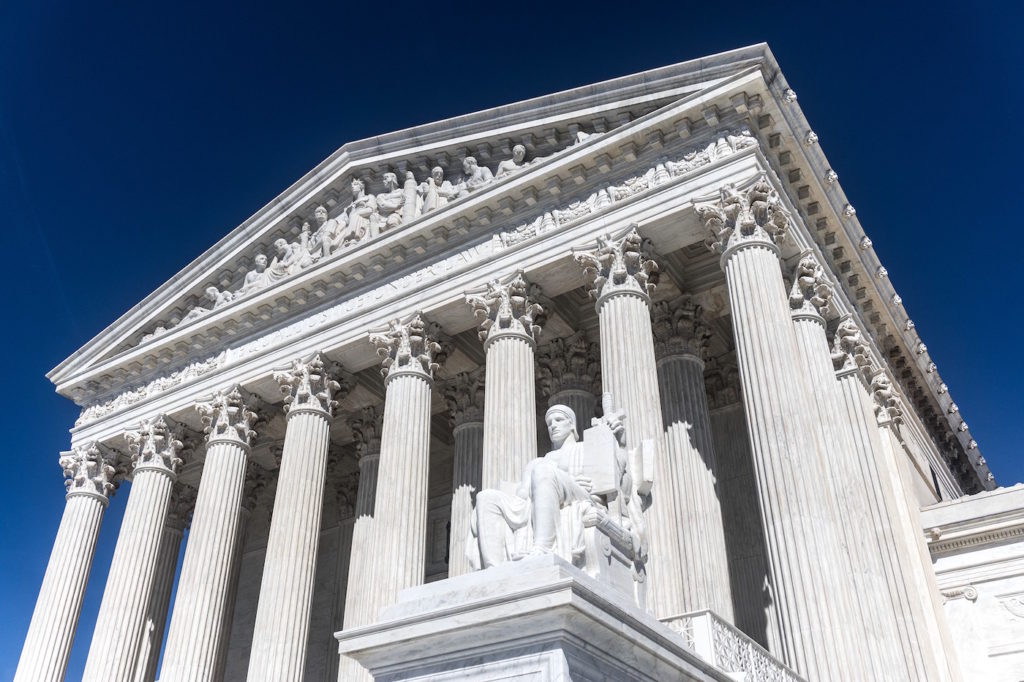Now that Brett Kavanaugh has been confirmed to the Supreme Court, liberals are turning their attention to ways the political system might limit the role of the courts or the influence of individual jurists. William Galston has argued for imposing term limits on justices of the Supreme Court. Others have suggesting packing the court the next time a Democrat occupies the White House, thus rendering each justice of less particular importance. Mark Tushnet of Harvard has come very close to suggesting shutting down the Supreme Court altogether.
Whatever the particular means proposed to limit the Court’s role, the only way the Kavanaugh appointment has made any headway in uniting left and right has been on this issue. Liberals are now coming around to a conservative understanding of a limited judiciary, one equal with rather than superior to the other branches of government.
So, are we going to see bipartisan movement to achieve these ends?
It’s unlikely. Why? Simple explanations abound. Some predict that Republicans will have little interest in limiting the power of the courts now that they control the Supreme Court and are appointing scores of lower court judges. Others opine that recent events have been so polarizing that working with the other side will be nearly impossible. Either explanation might be true, but both are too parochial to capture what is not only a bipartisan but an international phenomenon. Strangely, politicians everywhere seem happy to relinquish power to unelected bodies.
Start your day with Public Discourse
Sign up and get our daily essays sent straight to your inbox.An Example from Canada: The Notwithstanding Clause
The most instructive case is probably from Canada. The Canadian Charter of Rights and Freedoms contains a provision known as the “notwithstanding clause.” Although it is rarely invoked, it allows any federal or provincial legislature to override any provision of the Charter, thus shielding a law from judicial review.
This is an incredibly powerful political and legal weapon, but it has been fully used by only two provinces and has never been invoked by the federal government. There is no question about the legislative right to invoke it, yet it remains almost unused.
The notwithstanding clause was first invoked by the Quebec legislature in 1987 to apply to all of its laws, essentially invalidating the Charter in the entire province. This blanket practice is believed by many to have discredited any use of the clause. It was also seen as an affront to the Charter, since most of the laws were unlikely to be in violation of the Charter, anyway. But the next year, 1988, the Supreme Court of Canada overturned a Quebec law that banned the public display of commercial signs in any language other than French. The Quebec legislature responded by invoking the notwithstanding clause to protect a rewritten version of the law.
This might be the paradigm example of a legislative body clawing back power from the judiciary. However, after widespread criticism, including from the United Nations Human Rights Commission, the notwithstanding provisions were abandoned by the Quebec legislature in 1992.
The only other legislature to use the notwithstanding clause is Saskatchewan’s. The provincial government used the clause in 1986 in a law ordering striking teachers back to work, preemptively cutting off appeals to the right to assemble. It was later ruled unnecessary, as the province had the power to pass such a law anyway. Earlier this year, the Saskatchewan government used the clause to circumvent a court ruling that would have limited funding for Catholic schools.
In 2000, the Alberta legislature made a failed attempt to invoke the notwithstanding clause in order to limit marriage to opposite-sex individuals. The Supreme Court ruled marriage was a federal power, not a provincial one. Alberta, therefore, had no authority to make such a law, regardless of the notwithstanding clause (and Stephen Harper’s Conservative government tried to protect marriage at the federal level). Today, the notwithstanding clause is again making headlines in Canada as Premier Doug Ford of Ontario is threatening to use it to change the makeup of Toronto city council. In Quebec, the new government is threatening to use it to ban face veils among provincial workers.
The point of all these examples is simply this: Canadian legislatures at all levels have far more power to isolate their acts from judicial review than one could find in any current proposal in this country. And yet, even with these tools at hand, they have chosen to use them only rarely.
Jurisdiction Stripping in the United States
Jurisdiction stripping is the nearest the American system comes to the Notwithstanding Clause. According to Article III of the Constitution, Congress has the power to limit what areas fall under the purview of the federal courts. By regulating the areas of law from which the Supreme Court can hear petitions, Congress is said to “strip” the Court of jurisdiction. This is almost as powerful as the Canadian clause. Yet there remains a question of what Congress’s exact powers are. The case law is complicated and not entirely conclusive.
For instance, Patchak v. Zinke (2018) resulted in a 4-2-3 decision on whether Congress can end pending litigation through jurisdiction stripping. The case involved a landowner who objected to an adjacent property being taken into public trust as part of a plan to build a casino on Indian land. In the middle of the trial, a law was passed affirming the trust and explicitly dismissing any legal action against the decision of the Interior Department. Although the government won in this case, the contorted ruling demonstrates the confusion. Justice Thomas wrote an opinion for the Court that Justices Breyer, Alito, and Kagan joined. Yet Justice Breyer also filed his own concurring opinion and Justice Ginsburg filed yet another, which Justice Sotomayor joined, that agreed with the conclusion but for completely different reasons from those offered by Thomas and the others. To all of these, Chief Justice Roberts wrote a dissent joined by Justices Kennedy and Gorsuch.
Anyone trying to keep track of the decision along the usual left-right axis will be thwarted. The key to the dissent was that the Chief Justice and two associates claim the law passed by Congress was not a true case of jurisdiction stripping but a command that one party in an ongoing case win and the other lose. In the words of Chief Justice Roberts, “Contrary to the plurality, I would not cede unqualified authority to the Legislature to decide the outcome of such a case. Article III of the Constitution vests that responsibility in the Judiciary alone.”
A much more high-profile attempt at jurisdiction stripping involves the Military Commissions Act (2006). This law was enacted by Congress and signed by President Bush to deny habeas corpus for enemy combatants held at Guantanamo Bay. In Hamdan v. Rumsfeld (2006), the Court ruled that anyone captured in battle and held in a government facility anywhere in the world had a right to trial. The Military Commissions Act was written in response to the Hamdan ruling, so this is, perhaps, the best test of jurisdiction stripping that we have. The effort was thwarted 5-4 in Boumediene v. Bush (2008). The majority in this case ruled—in a classic left/right split—that detainees did have rights to habeas corpus. The court seems to have set a very high bar for jurisdiction stripping, or at least the liberal wing of the court has done so. There might be a change with the new balance on the court.
Will Conservative Justices Rein in Their Own Power?
American and Canadian legislatures are not outliers in their reluctance to wrest power from the courts. We see the same process in Europe. While there were many reasons for UK citizens to vote to leave the European Union, the most substantial was the notion of parliamentary sovereignty. Under the conditions of the union, EU law is (was) superior to acts of Parliament. It should seem very strange on its face, then, that the sitting prime minister, David Cameron, who called for the referendum, wanted to remain in the Union. The power of his office would have increased significantly with an exit. But if we put his decision in the context of democratic leaders willingly relinquishing their powers to courts, supranational bodies, or bureaucracies, it is one instance among many. The EU itself is the greatest case in point.
James Madison explained that the branches of government and its offices were devised so that ambition would counteract ambition. But what happens when officeholders’ ambitions are no longer directed against the other branches of government? This was supposed to be the motivating force behind the balance of powers, the very dynamic of checks and balances. If there is a crisis of democracy in this populist era, it is taking place at both the bottom and the top. “Fighting back” is now seen as a virtue in itself by voters on the left and right, explaining Donald Trump’s persistent support, newfound respect for Lindsey Graham, and an assertiveness bordering on insurrection in the “Resist” movement. Decades of legislators without chests—just look at how they have avoided difficult, even if popular, decisions on abortion, marriage, immigration, and other issues—have led to this.
The irony here is that the conservative majority now forming on the Supreme Court is probably the most likely configuration of the Court—and the most likely body in all of the advanced democracies—to return power to elected officials, whether they like it or not. The two justices appointed by President Trump have a clear track record of deference to the legislative branch in the area of jurisdiction stripping. Neil Gorsuch was a lawyer in the Bush administration when the initial efforts were made to strip jurisdiction from the courts. Brett Kavanaugh, while on the DC Circuit, joined a decision to overturn a lower court ruling against the government.
Perhaps the real source of liberal anxiety is not simply that a conservative-dominated court will become activist in the opposite direction. Rather, a more far-reaching consequence for the American left would be a repositioning of the Court as a coequal branch of government. Most of their major victories have come as “exercise[s] of raw judicial power,” to quote the dissent of Byron White from Doe v. Bolton (the companion case to Roe v. Wade). A “conservative” court—which really means an “originalist” court—is more likely to return the branches to their intended balance than to act in a partisan manner. But as my colleague Greg Weiner has pointed out, originalism is not something to be confined to the Supreme Court.













